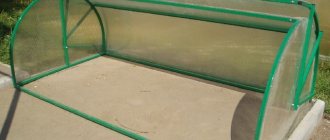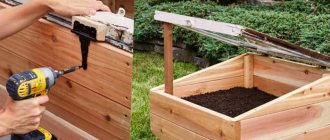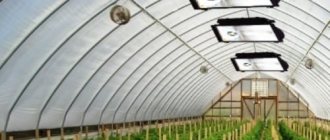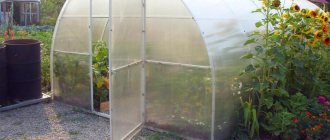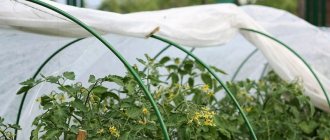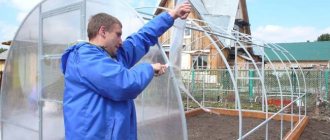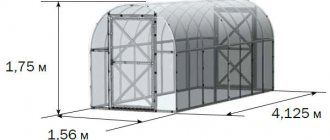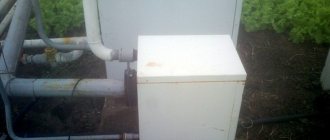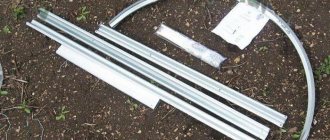When planning to grow crops indoors, it is necessary to choose the type of indoor structure that will provide effective protection of plants from cold, temperature changes, frosts, and heavy rainfall. It is not surprising if during the selection process the question arises of how a greenhouse differs from a greenhouse, because only by correctly setting priorities can you obtain maximum yields. You will also minimize capital investments and operating costs, and expand the list of cultivated plants.
Greenhouse and greenhouse - comparison
Main distinctive features and properties
A greenhouse and a greenhouse are used to solve one main problem, which is to protect crops from negative environmental factors. Therefore, you may get the impression that the difference between these structures is only in size: a greenhouse is usually smaller than a greenhouse. Actually this is not true.
Modern greenhouses are equipped with heating, lighting and ventilation systems
Dramatic difference in many respects
If you carefully look at the question of how a greenhouse differs from a greenhouse, it will be easy to notice that there are more differences than common properties. Having familiarized yourself with the design of these structures, the types of materials that are used to create frames and protective shelters, you can immediately identify differences in the following aspects:
- heating method;
- dimensions of the structure;
- crops grown;
- vegetation cycle;
- landing possibilities;
- types of materials used;
- ventilation methods;
- degree of mobility.
Further, each of the listed distinctive properties will be examined in detail, which will give a clear idea of the existing fundamental difference between greenhouses and hotbeds and ultimately will make it possible to use their advantages with maximum benefit, completely eliminating the disadvantages.
The greenhouse is compact and simple
Differences in story perspective
The use of mobile beds for the purpose of good heating of crops begins in Ancient Rome. Beds with vegetable crops were placed in wheeled carts and moved following the sun. At night and in bad weather they were placed in warm rooms, protecting them from the cold.
In the process of gradual improvement of these methods, mica and glass caps were created to cover the crops. These were already the first greenhouses. It was possible to grow plants brought from southern countries in them.
It was only in the 13th century that greenhouses began to be equipped with a simple heating system. From this time on, the era of greenhouses began, which made it possible to grow tropical and subtropical plants in the middle and northern latitudes.
Conclusion
Both greenhouses and hotbeds equally serve as the main assistant to the gardener. Without them, it is impossible to obtain a harvest of numerous varieties of vegetables, indoor plants or berries, for which the climate of a given area is not typical.
They allow you to collect fresh and healthy fruits even in the cold winter months. These structures can be purchased at a company store or made with your own hands. The quality will not suffer from this.
And the video in this article will show some of the nuances of this topic clearly, watch it!
Design solutions and mobility
Most of the territory of Russia, due to its difficult natural and climatic conditions, is a zone of risky agriculture. When growing crops in open ground, there is no guarantee that a harvest will be harvested that will at least compensate for the investment.
Greenhouses and greenhouses help solve this problem. Differing from each other in the most important parameters, complementing each other if necessary, they fully cover the needs of agricultural producers and gardeners in protected soil cultivation structures.
A greenhouse is a capital structure that can reach significant sizes.
Construction and equipment of greenhouses
Greenhouses are permanent structures with a foundation that separates the soil and the external cold soil.
They are equipped with a water, electric or fuel heating system, and may have special artificial lighting for the plants being grown.
In greenhouses, a microclimate is created that is independent of the ambient temperature; an unlimited increase in daylight hours is possible. All parameters are adjustable. The dimensions of the greenhouse reach hundreds of meters in length and exceed 2 meters in height, that is, sufficient to carry out work operations while being directly inside the structure.
The dimensions of the greenhouse reach hundreds of meters in length and exceed 2 meters in height, that is, sufficient to carry out work operations while being directly inside the structure.
Greenhouses and their features
Structurally, a greenhouse is a small-sized structure with side fences and a removable roof made of transparent material. The greenhouse has neither a foundation nor a floor and is immersed in the ground (soil) completely or partially. Artificial heating and lighting are not provided.
Cultivated plants are warmed due to the greenhouse effect formed inside the structure, mulching, and also due to the heat that is released during biological processes in the soil. The standard height of a greenhouse is no more than 1.3 meters. Therefore, when servicing the plants, a person is outside the structure.
Low plants grow well in a greenhouse
Building a greenhouse - step-by-step instructions
In our case, a greenhouse with a warm bed will be created. What kind of bed is this? This is a box made of boards, inside of which there is fine organic matter, compost and fertile soil. The first two components in the bed undergo a decomposition reaction and, as a result, produce heat that warms the plant roots and soil, promoting faster growth of crops. In addition, with such a greenhouse, you can start the summer season and plant seeds for seedlings even earlier.
As an example, a sketch of a greenhouse with a warm bed
Let's present the creation process in the form of step-by-step instructions.
Step 1. Measure and cut the boards to the width and length of the greenhouse. It is advisable to treat them on the inside with an antiseptic or cover them with polyethylene so that the wood box does not become damp.
Step 2. At the end of the long board, drill three holes for self-tapping screws.
Drilling holes
Important! Additionally, you can use a small crown to drill holes in the boards for the fastener heads.
Creating a recess for the fastener head
Step 3. Connect the first corner of the box with three self-tapping screws.
Connection of the first corner of the box
Step 4. Attach a bar stand to the corner from the inside, which is necessary to ensure a more reliable and strong connection of the box.
Fixing the strengthening post
Step 5. From the side of the short wall of the box, tighten two self-tapping screws, connecting it to the corner bar installed earlier.
The short wall is screwed to the bar
Step 6. The box for the warm greenhouse bed will be equipped with small sides. To hold them securely, attach wooden supports along the boards at some intervals.
Attaching a wooden support
The box for the warm bed is almost ready - all that remains is to install the sides
Step 7. Place edging boards on the long sides of the box. Fasten with self-tapping screws on corner posts, walls and supports.
Side boards laid
The boards are fastened with self-tapping screws
Step 8. After installing the sides, check the box for compliance with the diagonal dimensions. If there is no difference or it is minimal, everything is fine. Otherwise, the box and the greenhouse itself will be skewed.
Checking the diagonals of the box
Step 9. Install the sides according to the width of the future greenhouse. Make the fasteners in the same way as always - with self-tapping screws on the walls and supports.
Fastening the sides along the width of the structure
Step 10. It's time to fill the box with material for the warm bed. But first, cover the bottom with cardboard.
The bottom of the box is covered with cardboard
Advice! If rodents are common in your summer cottage or garden plot, first place a fine wire mesh on the bottom of the box, which will prevent pests from reaching the warm bed and plant roots.
Step 11. Now fill the box made of boards with a layer of fine organic matter, add compost and fertile soil on top.
Backfilling the box
Ready box with a warm bed. The next stage is the assembly of greenhouse arcs
Step 12. At intervals of 50-80 cm, drive metal rods inside the box that can be cut from reinforcement.
Metal rods are driven inside the box
Step 13. Cut a PVC or other flexible polymer pipe along the length of the future arches.
Step 14. Bend the pipe sections and install them in this form on rods driven into the ground.
Installation of greenhouse arcs
Step 15. Install a horizontal tie on top. To connect it to the arcs, you can use wire, angles and screws or, as in this example, steel staples.
The horizontal tie is connected to the arc with a steel bracket
Step 16. Cover the finished greenhouse frame with plastic wrap on top.
The greenhouse frame is covered with film
Step 17. Attach the film to the frame. Some people use slats for this, stuffed onto nails or screws on top, while others use a piece of rubber hose and clamps. Also, to hold the film, it is “propped up” with bricks and other heavy objects.
Attaching the film to the frame
The brick “props” the film
Important! When creating more permanent and durable greenhouses, it makes sense to secure the film to the frame using a construction stapler. But this complicates access to the plants and the ability to change the “covering” without much time.
Ready-made greenhouse with a “warm bed”. Remember to monitor the temperature inside so that the plants do not overheat
Video - DIY greenhouse
Range of crops grown
When considering how a greenhouse differs from a greenhouse, it is necessary to pay attention to the types and varieties of plants that are grown in them. On the possibility or impossibility of ensuring a full vegetation cycle. The range of crops directly depends on the microclimate maintained in the buildings, as well as on the dimensions: usable area and height.
The ability of greenhouses to ensure vegetation
In a greenhouse, the microclimate depends on the season, time of day, and weather. There are extremely limited possibilities for adjusting parameters such as air temperature, soil temperature, humidity and light levels. The difference in daily temperatures under and outside the shelter is relatively small.
The main purpose of a greenhouse is to grow seedlings and support germinating plants during a period when the air and soil temperatures are still insufficient for normal vegetation. When the temperature reaches the required level, the seedlings are planted in open ground or the greenhouse is simply removed without touching the plants.
In regions with cold and short summers, greenhouses are used for the full cycle of growing low-growing crops. A greenhouse differs from a greenhouse in that it does not provide conditions for growing heat-loving plants in cold climates and is used primarily for crops zoned in a given area.
Only in a greenhouse can you arrange
What can be grown in greenhouses
A greenhouse, unlike a greenhouse, is completely autonomous and does not depend directly on climate and weather. It is possible to set any parameters of temperature, humidity, lighting, air exchange, control and regulate them.
The conditions created in the greenhouse make it possible to successfully cultivate not only traditional tomatoes, cucumbers, peppers, but also subtropical fruits, including citrus fruits. The microclimate and size of the greenhouses make it possible to provide a full cycle of vegetation, from sowing to the full ripening of fruits.
The possibilities of greenhouses are much wider
High yields are ensured, sufficient for the commercial production of vegetable, fruit and flower crops. The cultivation of tropical “guests”, such as bananas and mangoes, is gaining popularity. Both “native” roses and chrysanthemums, as well as exotic flowers, grow well in greenhouses.
Difference between a Greenhouse and a Greenhouse: A Detailed Study
What is the difference between a greenhouse and a greenhouse?
Any gardener at some point thinks about purchasing a greenhouse or greenhouse, because increasing the yield on their plots is everyone’s dream. It may seem that there are no differences between the structures, but there is a difference. Therefore, it is worth talking separately about how a greenhouse differs from a greenhouse. And figure this issue out.
- 1 What exactly came first? 1.1 So what are the differences?
- 1.2 What about greenhouses?
From materials to service life and prices
When answering the question of how a greenhouse differs from a greenhouse, one cannot ignore the materials from which they are made, service life, the ability to move and the financial component. These are important factors. When there is a question of choice, they are able to tip the scales in one direction or another. Very often, beginning farmers only want to test their abilities, and at the start, it is not so much the service life of the structure that is important to them, but saving money.
Material of protective shelters and frames
A greenhouse is usually built for use during one season. The most popular covering material is polyethylene film. Due to the low weight of the structure, no high demands are placed on the frame. It can be made, for example, from wooden slats or plastic pipes.
Along with traditional greenhouses, collapsible polycarbonate structures are increasingly being used. They are easy to install and disassemble and do not take up much space during storage. Both options are good for testing your strength in growing crops in protected soil.
A polycarbonate greenhouse can also be used in winter
The greenhouse is designed for maximum long-term operation. For shelter, a full range of covering materials is used - polycarbonate, agrofibre, etc. Glass is also used, which requires a strong frame. This nuance is another difference between modern greenhouses and greenhouses.
Hydroponics is the prerogative of greenhouses
Basic Pricing Principles
A greenhouse is the simplest cultivation structure. Its price consists of the costs of materials, their delivery to the site and simple installation work, which you can do yourself. Considering the small dimensions of one structure, we can conclude that this is the most economical option for investment.
A greenhouse differs from a greenhouse in that it does not require significant operating costs to maintain the microclimate, since the natural resources of the environment, namely solar and biological energy, are used for this purpose.
A greenhouse, compared to a greenhouse, requires more costs, in particular for organizing and maintaining heating and artificial lighting.
It’s easy to build a film greenhouse from pipes
Agrofabric Kron
It is used as a flooring between cultural plantings. Most often used for mulching against weeds.
Agrofabric from the Kron company is presented in black, since black color is least susceptible to the penetration of ultraviolet rays.
Main functions and properties of agrofabric:
- Protects against weed formation
- Permeates air, water and mineral fertilizers
- Allows you to reduce the number of waterings
- Retains moisture in the soil
- Protects the root system of plants from overheating or hypothermia
- Increases soil fertility while retaining essential minerals
- Protects fruits from rotting
- Protects from pests
- Protects against frost
- Durable, minimum 4 years of service
Ready-made greenhouses
Currently, in stores you can purchase ready-made greenhouse designs with convenient fastenings and clamps for covering materials. Their price is quite affordable.
- Special arcs of various lengths and pointed tips fit perfectly into even the hardest soil and hold the covering material even in strong winds using special plastic clips.
- Given their convenience and ease of use, ready-made greenhouses can be used for more than one season.
I myself have repeatedly used ready-made greenhouse shelters. This significantly accelerated the emergence of seedlings and shortened the harvest time.
Greenhouses can be installed both outdoors and indoors, even on a balcony or loggia.
- Now compact mini-greenhouses or grow tents (grow boxes) have appeared.
- Their dimensions can be no more than 50x50 cm.
At home, seedlings, herbs, small shrubs or berries are most often grown.
Simple DIY greenhouse
I’ll tell you how to make a greenhouse with your own hands using the example of a frequently encountered classic greenhouse.
Greenhouse on manure
- A layer of manure, preferably horse manure, is placed in a dug trench about 0.5 m deep. It provides the most heat.
- After the manure settles, a layer of soil is poured on top. This will become the basis for the growth of our cultures.
Heating occurs due to self-heating of the manure layer.
- If there is a problem with manure, the greenhouse box can be installed directly on fertile humus soil without digging a trench. Heating in this case will only be solar.
- Manure is prepared in advance, because It’s not worth putting in a burnt-out one, it won’t be of much use.
When there is no longer a need for a greenhouse, the used manure can be used as fertilizer for the beds.
Greenhouse frame and cover
To install a greenhouse, it is advisable to choose a drier area that is well accessible to light and protected from harsh winds.
- When constructing the frame, the north side should be made 10-12 cm higher than the south side for uniform illumination of the plants.
- The covering material must fit tightly on all sides to avoid heat loss.
In the future, it is necessary to monitor the microclimate inside the greenhouse, ventilate and shade it if necessary.
Greenhouse: frame, shelter, dimensions and purpose
— A greenhouse, unlike a greenhouse, is a multifunctional, stationary, large structure (from 2 m and above) both in height and width.
— Another significant difference between a greenhouse and a greenhouse is the much higher material costs for a full range of equipment and maintenance.
- The greenhouse is installed on a foundation made of any suitable material: wood, cement, blocks.
- The greenhouse must have doors, windows or vents for caring for plantings and ventilation.
- The basis of greenhouses is a frame: arched, horizontal, gable, wall.
Our experience has shown that arched greenhouses are the most convenient:
|
Greenhouse frame
Frames are made of metal (galvanized steel), plastic or wood.
- The metal frame is more durable, stable and durable.
- The plastic must be very durable with an internal pipe diameter of more than 2 cm.
- Wood is very often used by summer residents due to its low cost, availability and environmental friendliness. However, the tree is very short-lived (lasts 5-10 years) and can quickly rot due to improper care.
Dimensions and purpose of the greenhouse
The areas of greenhouses vary depending on the area of activity, the possibility of care and the need for crop volume.
- Small greenhouses, up to 15 m², will be needed to satisfy the vegetable needs of a small family.
- You can place quite large volumes of not only seedlings in one greenhouse, but also get a full harvest of any crops, even quite large and tall ones: tomatoes, corn, watermelon, cabbage.
- Often, not one, but several types of plants are grown in a greenhouse, taking into account their compatibility.
- The main soil area is occupied by the most important crops.
- For more optimal use of protected soil, greenery, small root crops, vegetable and flower seedlings are planted along all sides of the greenhouse.
Large volumes of protected soil are necessary for the industrial production of seedlings, vegetable products and flowers.
| Tomato Everyone's envy F1 |
Innovative hybrid F1 is the envy of everyone, obtained in the classical way, without the use of GMOs.
- Early ripening, indeterminate, for closed ground.
- The bushes are sparsely leafed, compact and grow in height rather than in width.
- It is worth forming into 3-4 stems.
- The cluster is simple, consisting of 7-10 fruits.
The fruits have an excellent ratio of sugars and acids, which gives them a special, unusual, fruity taste and aroma.
- The fruits are round, glossy, weighing 60-80 g.
- As they mature, they acquire a rich blue-black-violet color.
- The pulp is dense, cherry-red in color.
The hybrid has excellent decorative properties - a wonderful and unique decoration for your garden.
The use of automatic devices in a greenhouse
The main difference between the protected soil of a greenhouse and a greenhouse is the installation of artificial additional heating, lighting and watering, and therefore the possibility of year-round use.
- The microclimate inside the greenhouse does not depend on the environment.
- In large greenhouses, the use of various mechanized devices and equipment is available. For example, you can install a semi-automatic drip irrigation system. Automation waters for several days even without your participation.
3. Moisture is supplied directly to the roots of the plants through the droppers of the automatic system. This significantly reduces the survival rate of weeds in the greenhouse.
4. It is possible to automatically feed plants with fertilizers during watering.
5. The automation can operate on regular batteries. There is no need to connect electricity to the greenhouse. The batteries last up to 8 months, i.e. for the entire summer season.
Video: Automatic drip irrigation system in the AquaDusya greenhouse
Which covering is better to choose for a greenhouse?
Typically, 3 types of materials are used to cover greenhouses: film, glass and polycarbonate. Other materials can also be used: agrofibre or spunbond.
Film for greenhouses
Film greenhouses are very common, easy to install and mobile.
Pros:
- PVC film is a cheap material, easy to use.
- Retains heat well and lets in almost all sunlight.
Minuses:
- short-lived, breaks quickly.
- Not suitable for use in winter.
WHICH FILM TO CHOOSE FOR A GREENHOUSE
Now there are many types of PVC films on sale that retain their quality for 3-5 years.
I have such a film greenhouse installed three years ago. No damage was noted during this period.
Polycarbonate for greenhouse
Polycarbonate is a very durable and flexible material. This is the most commonly used modern covering material for the summer and autumn-winter seasons.
Pros:
- Reflects hard ultraviolet rays.
- It is characterized by high light transmittance and scattering ability, resistance to temperature changes.
- It has increased resistance to impact loads, 200 times higher than that of glass coatings.
- Can be used for a long time.
Minuses:
- high flammability and relative high cost.
EXPERT COMMENT
Along with the fact that modern polycarbonate greenhouses are available to every family, they cannot be sold for next to nothing. They consist of a high-quality metal profile and cellular polycarbonate, so they have a reasonable cost in the range of 15-20 thousand rubles. And the price of premium models can reach 40 thousand rubles.
Therefore, you should not look for suspiciously cheap products - you will get a fake that will break in the winter from the weight of the snow or will rust in the coming year.
Choose durable and reliable Kremlin greenhouses.
Glass for greenhouse
Glass has a very long history of use, but is still successfully used to this day.
Pros:
- It has good transparency.
- Does not transmit ultraviolet radiation, which all plants need in small amounts.
Minuses:
- if the arrangement is insufficient, it creates an excess of heat.
- Needs a reinforced frame, because has a lot of weight.
- It is easily damaged by heavy precipitation (hail).
WHAT GREENHOUSE TO CHOOSE: TYPES, SHAPE, FRAMEWORK, COVERING
How many greenhouses and greenhouses do you need at your dacha?
- It is advisable to prepare 2 small greenhouses for your own needs, for example, 1x3 m.
- Use one for growing early cucumbers, and the other as a nursery for flowers or vegetables.
- If tomatoes do not ripen in open ground, a small greenhouse - 3x4 m - will also come in handy.
- Larger greenhouses are suitable for growing products for commercial purposes: from 15-30 m in length and 3-4 m in width.
- These examples are recommended for spring-summer and summer-autumn crop rotation. During the winter season, a family usually needs one medium-sized heated greenhouse.
When planning plantings in any variant, the feeding areas of different crops should be taken into account.
So, for example, on 1 m you can plant:
- no more than 3 tomato bushes,
- or 4-5 cucumber plants,
- or 1 zucchini.
GREENHOUSE CONSTRUCTION: AGRONOMIST'S ADVICE
Soil for greenhouses and greenhouses
Whatever structure you choose, you will not see a good harvest if you select the soil incorrectly. This is the key to future dacha success.
- Each crop requires its own soil. Even cultures of the same family differ in their preferences.
- The soil for cultivating adult plants is not entirely suitable for growing seedlings.
- One of the main requirements for soil is its acidity. Most vegetable crops prefer a neutral environment, less often a slightly acidic one.
- Air and moisture permeability are no less important.
How to cook
For a good harvest, you will need to bring or buy black soil into the greenhouse and hotbed.
It is advisable to add other nutritional ingredients to it in order to obtain fertile soil that is beneficial for plants:
- 30% black soil,
- 50% peat,
- 20% coarse sand.
Together, these components will give the soil the necessary nutritional value and a light, loose structure.
Many gardeners consider black soil the most important condition for a rich harvest. This is not always justified. It has a neutral environment, contains the highest percentage of humus of all soils, and will also fully satisfy all crops in nutrients.
When purchasing black soil, be careful:
- the use of chernozem is not always justified due to its high prices,
- Often, under the guise of black soil, they sell “substitutes” that are far from the original and do not bring the expected benefits.
Therefore, according to experienced summer residents, it is quite possible to prepare fertile soil yourself in the fall. There are plenty of recipes for the composition of components and improving soil fertility. You need to prepare fertile soil taking into account the physical and chemical composition of your site and the requirements of the set of priority crops grown on it.
HOW TO IMPROVE SOIL FERTILITY
Opportunities for the application of crop production technologies
The greenhouse is ideal as an auxiliary tool for growing crops in open ground and allows, with minimal costs, to significantly increase the profitability of the farm and expand the list of species and varieties of cultivated plants. A greenhouse is a completely self-sufficient cultivation structure and the only possible option for the production of agricultural products in an extremely unfavorable climate.
The dimensions of the greenhouse allow you to grow tall varieties of vegetables
Advantages and disadvantages of greenhouses and greenhouses
Due to their design, standard greenhouses do not allow the use of many modern plant cultivation technologies. Beds in greenhouses are placed directly on the ground without any adaptive elements.
Only in greenhouses can technologies and techniques such as hydroponics and the creation of high beds and placing them on special racks be used. Only in greenhouses can tall species and varieties of plants be grown.
In greenhouses, it is possible to use mechanization tools, including cultivators. If necessary, greenhouses are equipped with automation systems, in particular artificial irrigation, which facilitates labor and optimizes technological processes.
Greenhouses for one season
Ventilation techniques used
Manual and automated systems are used to remove excess heat and bring fresh air into the greenhouse and ensure optimal circulation. Ventilation can be carried out through vents and transoms, of which there must be at least two. For intensive air exchange, greenhouses are equipped with forced ventilation systems. Full automation of ventilation is possible.
The seasonal use of greenhouses makes it unnecessary to equip them with ventilation systems. To allow fresh air in, simply remove or push aside the protective material. Although in some cases, greenhouses are equipped with vents. Ventilation can also be provided due to a special design.
The hinged greenhouse lid will provide ventilation and convenient access to plants
General information
Industrial greenhouses are often glazed. Their structure includes a frame, foundation and roof. It is recommended to locate buildings from north to south.
Professional greenhouses can be made from different materials, but cellular polycarbonate is most often used. It has unique characteristics:
- high strength;
- low maintenance requirements;
- ability to withstand different temperatures;
- protection of plants from UV radiation;
- flexibility;
- ease of installation.
Farm greenhouses must have a vestibule that prevents cold or warm air from entering and leaving the room
Degree of mobility and transportability
Expanding the scope of activity and developing new territories requires relocation. Country farming is seasonal and requires conditions for maintaining technical means and equipment. Therefore, a high level of mobility is a distinctive feature of modernity.
Is it possible to move greenhouses?
Based on a criterion such as mobility, it is not easy to determine which is better: a greenhouse or a greenhouse, since both categories have mobile structures. Just a few years ago, greenhouses were predominantly stationary structures. Their movement was impossible or difficult.
With the advent of new technologies, the situation has changed and new types of greenhouses can be dismantled and transported without any damage. Moreover, in polycarbonate greenhouses the frame does not require fastening to the foundation, which further increases mobility. Sectional greenhouses are extremely easy to transport.
Transportation does not require heavy special transport and is carried out using microtrucks
What is a greenhouse?
A greenhouse is a non-portable structure that is used from early spring to late autumn.
It consists of a frame and a covering - cellular polycarbonate or film. The best option for the frame is galvanized steel. It does not rust, is highly durable and has a long service life.
Installation of a greenhouse begins with the foundation. All frames end in T-shaped ends that are firmly dug into the ground. Two or three beds are organized inside to plant more varieties. A good option to protect plants from weeds and save on watering is to buy metal beds and “Volya”. The coating used is film or cellular polycarbonate. The first is an inexpensive, fragile material, the second is more expensive, but will last much longer.
The greenhouse cannot be opened as a greenhouse, so you need to be prepared for the fact that you will have to water it or install special watering devices. Otherwise, a greenhouse can last at least 5 years, and with proper care, all ten.
Recommendations for making a greenhouse with your own hands at home
Useful tips for making a greenhouse:
- First, decide where the product will be placed, since its dimensions depend on this.
- Choose the type of frame for the structure and consider whether it will be seasonal or durable.
- Always make a drawing of the product to make it easier to calculate the required amount of materials.
- If you plan to manufacture a large structure, then assemble it on site so that you do not need to move it again.
Although a greenhouse and a greenhouse have the same purpose - to protect plants from the adverse effects of the external environment, they are different structures in their design. Each gardener must decide for himself which product to choose.
